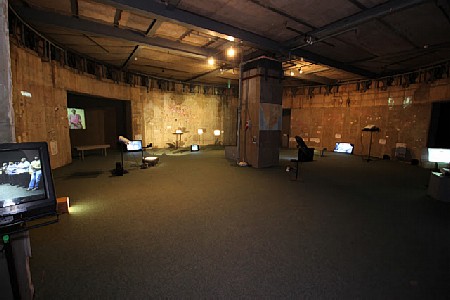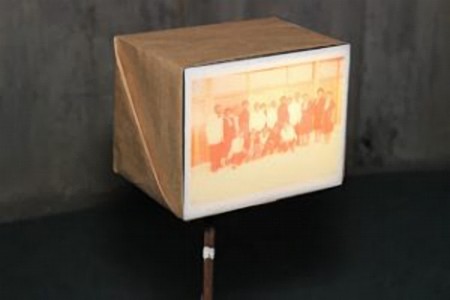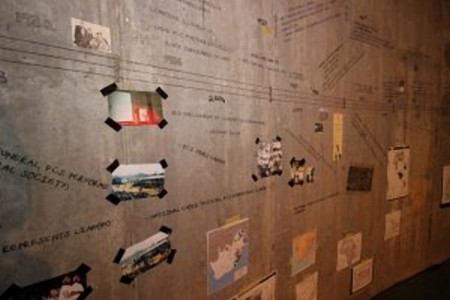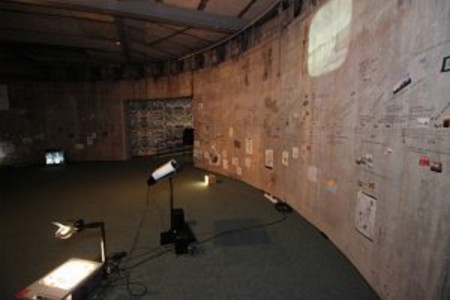Writing: Reviews & Think Pieces

Singing History: Dineo Seshee Bopape’s ‘Sa Koša Ke Lerole’
Dineo Seshee Bopape
By Jean-Sylvain Tshilumba Mukendi
National Arts Festival, Grahamstown
In ‘Sa Koša Ke Lerole’, exhibited during the National Arts Festival in Grahamstown, Dineo Seshee Bopape lays the history of the Polokwane Chorale Society – founded in 1977 – on the walls and structure of the Gallery in the Round located in the basement of the Settlers National Monument. In a sterling spatial arrangement of images, texts and sounds, she revives the voices of the first and longest living adult choir in the Limpopo region. Bopape’s artistic gesture is an act of recognition, documentation, narration and memory. The choir is no stranger to her, both of her parents members, respectively as conductor and chorister. Departing from a personal memory and experience, the exhibition transforms it through creative historicizing. Dineo Seshee Bopape honours The Polokwane Chorale Society. Even more, she retells the choir’s history, making it her own, subjugating it to her own subjectivity.

Dineo Seshee Bopape, ‘Sa Koša Ke Lerole’. Installation view: National Arts Festival, Grahamstown
The exhibition is brimming with historical, cultural and national references, which complement our understanding of the Polokwane Chorale Society’s evolution. Comprising memorabilia, videos and collages, ‘Sa Koša Ke Lerole’ distinguishes itself by its density, a distinct feature that leads inevitably to the question of space conception. In that exercise, Bopape excels. Arriving in the Gallery in the Round, we are welcomed by the names of those who have composed the choir and a large mural collage that sets the tone of the exhibition. Relying on the space’s architecture, Bopape let her work occupy the space, yet never determines it. The arrangement is circular, time-lined and extensive. The arrangement is thought-out from every nook and cranny, semi-closed off corners in which videos are on display. Interviews, archival footages, repeating sessions and Bopape’s own video compositions add to an already charged visual content. In a black and white video supplemented with a fisheye effect, and screened slightly below ceiling height, the choir is marching in a line, the members addressing individually the camera at times. The choreography and the editing is somehow reminiscent of Charlie Chaplin. At a chest height now, and along the circular (ground) plateau, Bopape has disposed several light boxes, covered by kraft paper, allowing images of the choir performing to reveal (themselves) on a side of the box.

Dineo Seshee Bopape, ‘Sa Koša Ke Lerole’. Installation view: National Arts Festival, Grahamstown
Circulating along the timeline, our attention is caught by the many inscriptions and pointers – very small at times – that frame Bopape’s act of narration. In this regard, the exhibition cannot be overlooked in the literal sense of the term. Information is plenty, to the extent that one cannot simply browse through ‘Sa Koša Ke Lerole’. However, attending an exhibition does not necessarily imply a thorough examining task. The show oscillates between a dedicated personal rendering of an influential chapter of the artist’s life, and a more rigorous museum essay. In this oscillation, a real performative act, Bopape’s aesthetic and conceptual backgrounds merge to offer a unique visual experience.
Music has often been a starting point in Bopape’s work. The melodies of ‘Sa Koša Ke Lerole’ echo a prolific past with notes of communal intentions, deferring nostalgia in favour of recognition, acknowledgement and collective inspiration. The Polokwane Chorale Society is first and foremost a community project that gathers individuals to form a harmonious vocal ensemble. The choir carries a multitude of voices under a common one. In imagining such a plural, idiosyncratic, diffuse yet coherent restitution, Bopape offers many insights through which one can give meaning to the choir and its broader relevance for South Africa. We relate simultaneously to a national, provincial and personal heritage.

Dineo Seshee Bopape, ‘Sa Koša Ke Lerole’. Installation view: National Arts Festival, Grahamstown
The 2017 Standard Bank Young Artist for Performance Art practices outside expectations. In foregrounding and bringing to attention a story close to her and giving it a communal weight, she makes a statement about creativity in the visual and performance arts. Delighted by her ability to do so, it strengthened my belief in the possibility, the myriad of possibilities in fact, to embrace artistically our familial heritage, our rootedness in a historical and personal legacy. Bopape’s documenting subjectivity upholds the faith in the artistic relevance of the constitutive, particular and ordinary chapters of our life. Carefully positioning the memorabilia and visual points of entry to the Polokwane Chorale Society, Bopape never rigidly frames our perception and relation to it. The result is a wandering stroll similar to the effect of an unknown or new song in one’s ear. Whether a revelation or an uncertainty, I should perhaps listen to it again to unveil its complexities. The different tones of voice that compose a choir, when well conducted, can reverberate in the corners of our soul, our humanity. After all, when there is music, we all dance.
This article was first published in Artthrob
Jean-Sylvain Tshilumba Mukendi is an art writer and is currently completing a Master within the 'Arts of Africa and the Global South' research programme (NRF) at Rhodes University, South Africa. His research focuses on the relevance of ‘globalism’ in the contemporary art world, the establishment of independent art structures in Africa and the development of photography practices over the continent.
Last Modified: Fri, 08 Sep 2017 16:07:33 SAST
